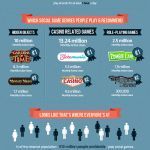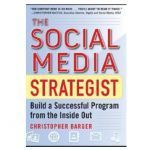Erik Qualman's Blog, page 675
January 22, 2012
Facebook EdgeRank Ninjutsu: Social Marketing Discussion with Taulbee Jackson

[image error]Did you know that there is an invisible, silent force that determines your Facebook success, and that mastering this force can give you an advantage over your competitors?
That force is called EdgeRank, and we sat down with Taulbee Jackson, President and CEO of Raidious, one of the leading interactive marketing companies, to discuss how marketers can harness its power. We'll be devoting an entire hour to the subject during our webinar with him next week: EdgeRank Ninjutsu: How to Optimize Content for EdgeRank Success.
Why should marketers understand EdgeRank?
Lots of brands have invested heavily in developing audiences on Facebook – using not just technology and tools but also allocating human resources to the task. Although brands are producing content in an effort to engage with their Facebook fans, it is ultimately the EdgeRank algorithm that determines whether this content gets displayed to fans. Many companies end up spending time and money to develop their audience, but in reality only reaching a small percentage of them. Understanding EdgeRank can equip marketers with the critical insights to help them get more fans and keep them engaged over time. The long-term implications of EdgeRank are also important, particularly if a brand is integrating Facebook functionality into their site. We think EdgeRank can have more profound long-term ramifications than the Google algorithm for many marketers.
What was the most surprising fact about EdgeRank you discovered when researching for this webinar?
The brilliance of EdgeRank and its targeting sophistication compared to that of other algorithms such as Google's was surprising. Facebook uses a lot more and richer data than Google, analyzing and understanding relationships between key data points, which enables it to expose what's really valuable for and relevant to its users. I was surprised to see how much Facebook cares about content quality and user engagement. They have gone to great lengths to make sure their users are not just seeing the content they know they want, but also offering content they may be interested, but didn't know they wanted. This says a lot about Facebook's commitment to its users. It also points to Facebook's enormous potential to monetize their growing membership.
Google is more forward with the public when they make changes to their algorithm, while Facebook hardly every talks about EdgeRank. Why do you think that is?
Google's algorithm has been around a lot longer, and entire industries have sprung up around understanding and utilizing that algorithm. Google is not more transparent with their algorithm, it's just that there are lot more SEO people monitoring it closely and sharing their insights. And because there are a lot more people focused on manipulating Google search, they have caught Google's attention and made it important for the company to help these people understand what Google is aiming to accomplish. Google is focused on providing the best search results possible, and by sharing information about their updates, they help website publishers navigate these changes.
What are some tactics you have implemented with clients to specifically improve EdgeRank?
We have tested timing of posts and formats. As a result we have shifting our content approach to be more oriented towards rich media formats, which has been very successful for our clients. Proactively engaging communities and empowering fans to create and share their own content have also proven to be effective. The most important "tactic" for Raidious has always been treating marketing as a science experiment – test and optimize, then test and optimize some more, regardless of whether it is Facebook, email, Twitter, or blogposts. If you're not constantly trying new things, you won't know if you can do better.
What do you see for the future of EdgeRank?
As marketers begin to see the profound potential of the Facebook data – and the data-driven impact Facebook can have for brands, marketers will start pulling more of the Facebook data insights into their owned media properties – such as websites, mobile apps, blogs, etc. Equipped with new access to rich, meaningful user data, marketers will be able to offer deeply personalized user experiences. Facebook profiles will start to replace your email inbox, as it becomes your "key to the Internet". Facebook is getting closer to achieving the data-driven marketer's dream – capturing deep user preference insights that will empower marketers to connect products with both the known and unrealized needs of their target audience. Our company is one of the first of many that will focus on EdgeRank optimization as a core user engagement function, and we anticipate a new EdgeRank industry springing up similarly to the way the SEO industry has evolved.
For more insights from Taulbee Jackson, be sure to attend our free Awareness webinar on Wednesday, January 25, at 2 pm EST: EdgeRank Ninjutsu: How to Optimize Content for EdgeRank Success.
You can also post your questions for Taulbee in the comment section of this blogpost, on Twitter, Facebook or LinkedIn.
[image error]
January 20, 2012
Social Gaming Infographic: 81 Million Play Each Day + More Stats

Social Gaming is huge, but even some of these stats blew me away in this social and mobile gaming infographic:
[image error] Source: Prism Casino (click here to get full mobile gaming statistics)
[image error]
Twitter Spreads News of Canadian Freestyle Skier Sarah Burke's Death

[image error]For many of us in or just past the Baby Boomers generation, we grew up getting much of our breaking news via radio, television or the daily newspaper.
Today's generation, however, simply needs to Internet access and they can stay update to date with the latest and breaking news worldwide.
As many of us first learned on Twitter Jan. 19, Canadian freestyle skier Sarah Burke passed away Thursday in a Utah hospital, only nine days after crashing at the bottom of the superpipe during a training run in Park City, Utah. The Ontario (Canada) was married and just 29 years of age.
As noted in the details of her death, tests showed Burke sustained "irreversible damage to her brain due to lack of oxygen and blood after cardiac arrest."
The four-time Winter X Games champ, who successfully lobbied to have her sport debut at the 2014 Olympic in Sochi, Russia, tore her vertebral artery, which led to severe bleeding on the brain. The accident caused her to go into cardiac arrest on the scene, and she was on life support up until Thursday morning. A publicist reported that Burke's organs and tissues were donated per her wishes.
"I've been doing this for long time, 11 years," Burke commented in a 2010 interview. "I've been very lucky with the injuries I've had. It's part of the game. Everybody gets hurt. Looking back on it, I'd probably do the exact same thing again."
While many Canadians and ski lovers worldwide are and will mourn Burke's the death, the speed with which many of us learned about her passing is in large part due to Twitter.
Just like the fight for freedom in parts of the Middle East last year, along with the deaths of Osama bin Laden and Muammar Gaddafi, much of the news we hear of worldwide is coming to us via social media venues such as Twitter.
While some argue that sites such as Twitter can at times provide nothing more than rumors, such as Colts' QB Peyton Manning reportedly retiring before he actually does, social media venues like Twitter and Facebook have implanted themselves as part of our daily news intake.
Anytime news such as that like Burke's death appears on sites like Twitter, it is important to make sure that it is factual to say the least.
That being said, many people like me, someone who has been in the field of journalism for some 23 years, are keeping one eye on Twitter and Facebook and another on the "real news outlets" during the day.
Then again, maybe some of these social media sites are becoming the "real news outlets" of this online information-driven age.
Photo credit: globalnews.ca
[image error]
2012 Key Social Technology Predictions from Top Business and Marketing Strategists

[image error]2011 was a year of increased adoption of social technologies within the enterprise, and that trend will continue into 2012. In their fifth annual survey of over 4,200 global executives, McKinsey concludes that when adopted at scale, "social technologies can boost a company's financial performance and market share." To help stay ahead of this wave of change, we connected with 34 top business and marketing strategies to get their take on the key technologies that will impact marketing and sales in 2012 for our free eBook 2012 Social Marketing & New Media Predictions. Here are some of their top predictions:
Integrated Analytics for Market-Driven Insights – 2012 will see marketing empowered by sophisticated analytics – with companies, their marketing analytics teams and their social technology vendors coming together to turn the deluge of social data into actionable, measurable insights. Brian Solis and David Meerman Scott point to this trend as shaping how businesses will communicate and engage with their constituents – with market-driven and not-marketing driven insights, as Brian Solis clarifies. These insights will be augmented by new technologies that will accurately measure influence and engagement, adds Paul Gillin. Ekaterina Walters at Intel also gives integrated analytics thumbs up, commenting that until brands have the tools to measure the right things at the right time an integrated way, "we won't know what the impact is."
Toolset/ CRM Integration: 2012 is also touted as the year where we will see further integration of the social technology toolset. Jason Falls of Social Media Explorer and No Bullshit Social Media predicts monitoring platforms will be adding publishing and management solutions, while social platforms will evolve to include e-mail, mobile and website management. The social technology toolset will also see a tighter integration between social data and CRM and web analytics solutions. This tighter social CRM (sCRM) integration will allow brands to address the ROI question and measure the impact on bottom-line results. Errol Apostolopoulos at Optaros, Inc. adds that marketers can expect to see numbers that reflect revenue per fan along "with proven ways to tap into the interest graph", which will lead to "a lot more social success stories". Marc Meyer of the Digital Response Marketing Group votes for the integrated dashboard – bundling marketing, monitoring and management "to address multiple accounts and reduce multiple logins and processes."
The Year of Mobile: 2012 is (yet again) proclaimed as the year of mobile. Smart phones are becoming the primary channel for users to interact with social networks. David Berkowitz shares 2012 will be the year Facebook will have more than half of its users accessing it from mobile devices. Debi Kleiman of MITX predicts that this mobile shift "will require brands to completely rethink how they connect and communicate with consumers." Jim Storer adds that mobile will become "an imperative, not just a nice-to-have."
Jay Baer believes that we will see a more concerted efforts by companies to make their content mobile-friendly, while near-field communications (NFL) opportunities will drive relevancy, immediacy and tractions for the mobile-savvy brands. As Neil Glassman puts it, NFL will be about "real, real-time marketing." Mark Lazen of Social Media Today and The Customer Collective agrees that ultimately, mobile will open up marketing opportunities for relevancy.
Trends to Watch For: Other key social technology developments likely to impact the enterprise this year include – video, Google +, Facebook Edgerank, open APIs, inbound marketing tools and interactive voice response. Access all 140+ predictions on what the experts agree would be the top social technology developments in 2012. Our free eBook 2012 Social Marketing & New Media Predictions also includes predictions on top social marketing developments, biggest challenges, and top news resources. To get the latest from the experts quoted in the 2012 Social Marketing and New Media Predictions, you can follow them on Twitter.
We welcome your thoughts, reactions, and feedback. Other social tech developments likely to impact us this year? Let's continue the discussion in the comments below, on Twitter at hashtag #AwarenessSMM, Facebook at Social Media Marketing Best Practices, LinkedIn at the Social Media Marketing Mavens Group.
Mike Lewis
@BostonMike
[image error]
January 18, 2012
10 Companies SOPA Could Destroy and Why

[image error]One of 2011′s most hotly contested political issues, the Stop Online Piracy Act, has spilled over into 2012. Kate Croston of Internet Service penned a great post on SOPA and sent it our way. The language and far-reaching implications of the bill have caused high-profile workers within the entertainment industry to publicly oppose it; even supporters admit that it could vastly change the internet as we know it. Here are ten of the popular websites that could be potentially destroyed, should SOPA pass.
Facebook – Indisputably one of the most popular social networking sites in the history of the internet, Facebook boasts more than 800 million users around the globe. These users are currently able to post any link they like to their walls or those of their friends; those links can house legal and illegal content with no repercussions to the site itself. Under SOPA, advertizing revenue and any payments could be blocked for the entire network, should one complaint of infringing content be filed.
YouTube – Anyone who uses video-sharing giant YouTube has, at some point, come across a clip that's been removed due to copyright infringement complaints. In the event of SOPA's passing, each time one of those videos are reported, all revenue generated by the ads on the site would be blocked. Millions of dollars could be potentially lost.
Twitter – The number of tweets posted by Twitter users each day is estimated to be in the range of about 50 million; this mind-boggling volume of information shared by users worldwide makes it almost impossible to monitor on an individual basis, opening the door for SOPA-infringing complaints that—you guessed it—block ad revenue. One tweet with a link to copyrighted material could easily shut down all payments to the site until the situation is resolved.
Google – In addition to limiting the search results that would legally be allowed, Google's cash cow AdSense could also be affected by SOPA. This one-two punch might not spell the end for the company immediately, but could change the way services operate to the extent that they'd be virtually unrecognizable by pre-SOPA standards.
MegaUpload – File locker sites like MegaUpload definitely house a vast amount of pirated media, but they're also frequently used for legitimate file-sharing and backup purposes, which is where the conundrum sets in. While other lockers at least pay lip-service to the idea of DMCA laws, MegaUpload blatantly thumbs their collective noses at the notion of removing copyrighted material. As a result, SOPA is ostensibly worded specifically to police such sites, up to and including blocking access to American internet users altogether.
Tumblr – Many popular sites have a section related to sharing the content they house; among the buttons is a link to micro-blogging powerhouse Tumblr. With one click, Tumblr users can share links to almost anything; this feature would effectively cripple the site in the event of SOPA's enactment. Concerns about the bill spurred the site's administrators to launch a simulated censorship "blackout," during which users were presented with a real-life representation of what the bill could do; the change prompted users to call their House Representatives at an average of 3.6 calls per second at its peak.
Etsy – The online marketplace for handcrafted, vintage and artisan wares Etsy could find themselves devastated by SOPA in the event of a copyright infringement accusation. The sheer number of products offered by sellers creates a dilemma for the site; approving each item before posting would be virtually impossible. Should a craftsperson offer one product with infringing artwork, the bill could stop payment on each and every transaction facilitated by the site.
Flickr – Though the site makes a concerted effort to prevent the hosting of copyrighted images and takes removal requests very seriously, Flickr could easily be disabled by SOPA. Blacklisting the site and blocking it at a DNS level would be well within the scope of the bill, should one illegally shared image be discovered.
Reddit – The Reddit community has been among the most vocal in its opposition of SOPA, which has been dubbed the American Internet Censorship Act by users. Because the foundation of the site is sharing content, it would be impossible to regulate every shared link. Administrators have publicly stated that they would almost certainly be forced into shutting down if the act passes.
Digg – Like Reddit, Digg is primarily a content sharing site. Links to streaming video and other information are shared by users and suggested; compliance with SOPA would require that each link be housed on a site with absolutely no infringing content. Essentially, a legitimate link could still wreak havoc, should the linked site contain even one illegally shared piece of content. Combing every site in its entirety before allowing a link to be posted would be impossible, which could easily lead to Digg's demise.
[image error]
40+ Items Tech Will Kill this Digital Decade

Blind dates, instruction manuals, desktop computers, offline voting, homework, car keys, resumes, wrist watches and more will be replaced this digital decade by advances in technology. This month everyone in the tech community and beyond is trying to predict what is going to happen in the coming year. As a different exercise I wanted to take a look at what will no longer exist when this decade concludes.
I've taken my best stab, some more outlandish than others. Please see the list and video below (video will not play on mobile devices due to YouTube restrictions on third-party content).
1. Wrist Watches: Sure some will still wear for fashion or swimming, but ask a Gen Y or Z crowd to raise their hand if they aren't wearing a wristwatch and you will see many naked wrists in the air
2. Paperbacks: I still love a good book in my hands, but more and more I find myself cheating on my first love with my new love – Ms. Kindle.
3. Traditional Homework: With offerings like Khan Academy and MITx more and more teachers assigning watching a lecture or lesson on YouTube as the homework and then doing the "traditional homework" in the classroom with the help of the instructor and peers. Being able to watch the best in the world deliver a lecture on a topic is a much better way to learn when you combine it with in-class practice. I wish this were around when I went to school – break out the popcorn!
4. Newspapers
5. Car Keys
6. College Backpacks: Imagine how nice it will be just to carry around a tablet with all your textbooks accessible in the cloud. And they won't cost $150 either. Also you will be able to see the notes of all the other A+ students from around the world rather than praying that the used book you just purchased was from the next Einstein rather than the next Stoner. The books will be auto-updated as well.
7. DVDs
8. Instruction Manuals: Replaced my much easier to comprehend "How To" videos
9. Corked Wine: Screw Tops are better technology, but not quite as romantic
10. Offline Voting: No more "hanging chads" and imagine the percentage of voter increase when you can do it with a click of a button from your house. Even better, the results will be real-time.
11. Cash: Mobile phones become transactional
12. Desktop Computers
13. Paper Shredders
14. Post Offices: We are already seeing a record number of Post Office closings across the United States. Take advantage now and send someone a handwritten note (watch the hand cramps)
15. 2D: And we thought High Definition was cool
16. Boring Airplanes: With WiFi standard on every plane soon, in the future we may not want to disembark!
17. Paper Resumes: Hello LinkedIn and online reputation management
18. Blind Dates: Sad, but true. With so much information out there and friends of friends, the truly blind date will cease to exist #adiosakwardmoments
19. Broadcast TV: As discussed in Socialnomics everything will eventually be streamed – it's simply better technology
20. Education Inequality: With tools like YouTube for Schools and Khan Academy everyone will have access to great educational content. Everyone that is that has access to the Internet. The hope is that with increases in WiFi availability and decreases in hardware costs on tablets and smartphones that this becomes a reality.
21. Clipping Coupons: With the success of Travelzoo Local, GroupOn, Living Social and others, most coupons are becoming digital.
22. Hotel Internet Fees: Hopefully we can all wave bye-bye to the $14.95 Internet Fees at hotels, just like we no longer use the hotel phone for long distance calls
23. Checkbooks: Online Banking and PayPal
24. Face-to-Face: Sad, but true. We have less interpersonal communication than in years past
25. Credit Cards: Dealing direct with iTunes, Amazon, etc. and using your mobile device saves everyone money…except Visa, Master Card, Discover and American Express.
26. MTV: Actually that died already. Anyone wanting to launch their music career in "Lady Gaga" or "Justin Bieber" fashion knows YouTube is the key
27. Alarm Clocks: Replaced by Smartphones
28. Terrestrial Radio: Replaced by satellite radio
29. Greeting Cards: If the post office is gone and we're all trying to be green we all may get an e-Card in the years to come
30. Big Box Stores (like Best Buy): If the best reviews and ratings are online as well as the cheapest prices, why deal with all the hassles of going to the store to pay more? Similar to Blockbuster stores going away.
31. Gossip: Actually this will still exist, we'll just type it
32. Tollbooth Operators
33. Leaders: Well future leaders will need new digital leadership skills starting today and in the digital decades ahead
34. Channel Surfing
35. Movie Phone Times: Remember having to sit through all the recorded times (great Seinfeld episode on this too btw) to get the movie time you wanted #painful #alwaysthelastonelisted
36. Armor Cars: See cash above
37. Airline Gate Agents: Now if only we could get read of airline security lines…
38. Mail Order Catalogs
39. Expert Movie Critiques: Would you rather trust 4,573 reviews on Rotten Tomatoes, Yelp or Yahoo or two talking heads that have no idea what your tastes are? There is safety in numbers my friends #itssimplemath
40. 411
41. Gas Stations: OK, this is more of a dream ☺
42. Smartless Phones
43. Memo Pads
44. Classrooms: Home schooling will now be for the cool kids rather than the outcasts
45. Paper Maps
46. Texting in the Car: Well at least it will hopefully be illegal when you are driving. Studies have shown texting while driving is more dangerous than drinking and driving
47. Computer Mouse
48. Privacy: All these benefits do come at a cost. As Scott Monty of Ford says: "We will all have our fifteen minutes of privacy."
Research for my new book Digital Leader spurred this thought and video. While I researched what skills and habits were needed to lead our best life in this hyper-connected Digital Decade (hint: simplify and fail fast, fail forward, fail better) I thought it would be fun to showcase just how quickly items can change. Do you agree with the video?
[image error]
State of Social Media Marketing: New Report on Top Areas For Social Marketing Investment and Biggest Social Marketing Challenges in 2012

[image error]We are excited to share our annual report on the State of Social Media Marketing – Top Areas For Social Marketing Investment and Biggest Social Marketing Challenges in 2012. The team at Awareness connected with 320 marketers from a cross-section of industries, company sizes and levels of social marketing experience. Our annual State of Social Media Marketing report comes with insights from those leading the efforts at the C-level and those who manage the social marketing function within their organizations, as well as a number of business leaders who are helping to bridge the social gap within their enterprises.
The findings and insights contained in this report are revealing on a number of levels.
2012: The Year of Growing Social Marketing Maturity
Social marketing is entering a stage of maturity and with it, savvy, socially-oriented businesses are starting to embrace social as part of their companies' DNA. This transition comes with an understanding that siloed approaches to social marketing are not effective, and a realization that scale with social marketing comes with the adoption of new organizational structures, processes and technology infrastructure that can help the enterprise scale and optimize in a continuous fashion. Expect that in 2012 focus will shift to active social media management for increased lead generation and sales.
C-level Involvement with Social Marketing
We were excited with the response levels from C-level executives (39% of respondents) and the information they shared. Top-of-mind for executives and senior managers is ROI, integration of social with lead generation and sales, and expansion of social presence and reach. It is clear that the C-level wants more proof before they allocate additional organizational resources to social marketing. This is why only 8% of our respondents reported 2011 budgets of over $50,000 per year, with 12% of the organizations reporting teams of 5+ social marketers. At the same time, executives need to realize that to give their social marketing initiatives a chance, they need to invest accordingly in the effort. Our prediction is that to resolve the cost-benefit conundrum in 2012, executives will start to adopt new processes and technologies that will not only help them scale the effort, but get the data that clearly links to ROI.
The Right Social Marketing Infrastructure
Social marketing maturity will increasingly be defined next year as the practice of adopting new processes and technologies that will help the enterprise scale their initiatives. 2012 will see savvy social businesses moving beyond the "let's allocate a few people resources to social" mentality to incorporating robust social media management platforms. These platform will provide the ability to monitor and analyze social conversations, while creating effective response and content mechanisms to increase customer engagement and ultimately sales. Our industry is reaching this maturity tipping point – 78% of marketers reported monitoring social media channels for mentions of their brand at least a few times a week, while 62% reported monitoring industry conversations with the same frequency. Although 19% of surveyed marketers reported using a social media management platform, these are the leaders who will be reaping the most benefit from their efforts.
Expanded Use of New Social Marketing Platforms
Experienced social marketers report that they plan increased usage of social marketing platforms beyond the Big Three (Facebook, Twitter, and LinkedIn) to include: Blogs (91%) YouTube (86%), foursquare (59%), SlideShare (43%), Flickr (50%), and Tumblr (30%). Driven by increasingly fragmented user consumption habits, companies clearly see the need to expanded social presence that will allow them to follow and engage their prospects and customers on multiple channels and networks. This proliferation of channels and the corresponding need to successfully engage in all of them will make the job of social marketers increasingly more complex. This, in turn, will necessitate the adoption of robust tools to manage presence, monitor and report on activity, and tie efforts to the organizational bottom line.
The State of Social Media Marketing report contains additional insights on top social marketing investment areas, top challenges for 2012, top social media platforms used today, the role of LinkedIn in reaching the C-suite, along with a fun section on the top news and analysis resources marketers use to stay on top of the latest and greatest in our industry. For full, free access to the State of Social Media Marketing report, click here. If you would like to be included in the survey for next year's report, click here. You can also access the 2012 Social Marketing and New Media Predictions, to hear from marketing strategists David Meerman Scott, Brian Solis, Erik Qualman, Paul Gillin, CC Chapman, and Steve Rubel what 2012 has in store for us.
We welcome your thoughts, reactions and feedback. Let us know how the insights and findings presented in the State of Social Media Marketing report will help shape your thinking in 2012. Don't hesitate to ask us the tough questions – as we embark on 2012, we promise to continue to provide deeper dives into best practices, successes, and notable trends to help you, social marketers, do more and do better.
Follow us on Twitter: @awarenessinc
Join us on Facebook
Social Media Marketing Best Practices
Social Media Marketing Mavens Pages
Join our LinkedInGorup:
Social Media Marketing Mavens Group
Happy New Social Year,
Brain Zanghi,
CEO, Awareness, Inc.
[image error]
January 17, 2012
The Social Strategist: Social Marketing Discussion with Chris Barger

[image error]ateWhen it comes to social media for the enterprise, you'd be hard pressed to find a more qualified expert than Chris Barger. He spent four years as Director of Global Social Media at General Motors, served as IBM's "blogger-in-chief", and is now the Senior Vice President of Global Programs at Voce Connect. Chris also recently penned The Social Media Strategist: Build a Successful Program from the Inside Out. In anticipation of our Social Media Strategist webinar with him next week, we sat down with Chris for some serious social marketing Q and A.
What company most impressed you with their social marketing in 2011?
I continue to respect what American Express does in using social media to service small business customers. I also liked Heinz's Facebook campaign in the UK that allowed users to send sick friends a can of chicken soup. But my absolute favorite was how the Muppets were reintroduced to a new generation before the movie was released largely through social channels and YouTube videos. Follow Statler and Waldorf on Twitter? Brilliant. (Disclosure: while we don't work with the Disney movie or entertainment team, DisneyWorld is a client so I suppose that's in the family.)
What will be the biggest changes to the social media landscape to affect marketers in 2012?
First, social media marketing has matured into a 'mainstream' business practice, recognized by most organizations as a legitimate and needed aspect of the marketing communications function. This means an increased emphasis on metrics and measurement and key performance indicators (KPIs); the concept of conversations or engagement for their own sake will diminish in importance.
Also, consumers are much more savvy about social media marketing than they were even just a couple of years ago. A brand's mere presence within social networks isn't really going to impress anyone; we're going to have to be smarter and more creative about how we interact with people within these networks if we want to have an impact.
Your book – The Social Media Strategist: Build a Successful Program from the Inside Out, focuses on the social challenges for large companies. What were some of the more surprising hurdles you encountered when harnessing social marketing for these large companies?
There were several! What was interesting when I first got started at GM was the challenge of getting people inside the company to take social media seriously and to return my calls; by the time our program matured and I moved on, the challenge was getting people across the organization to coordinate their activities, and not execute disparate social strategies in silos. Which brings up one of the bigger hurdles I've observed at many large companies: turf wars over control of social. Social is hot right now, and between communications, marketing, web development and other groups within an organization, there's such a scramble for "who owns social". Some organizations are hamstringing their external efforts because they can't get out of their own way long enough to present a unified presence online.
Related to that: I'm always surprised at how often social is turned over to either someone in marketing or PR who's not even active in social networks (and thus can't really know the audience) or is active in social but way down on the food chain in the business (like an intern or a new hire) who can't really know enough about the business and its core spirit or messages. Would you have an intern calling the NY Times and managing your media relations program? Would you have someone running your broadcast media buys who doesn't even watch TV? No? So why turn over a core marketing or communications program to someone not experienced or knowledgeable enough to lead it?
Another hurdle is that measurement of social media success isn't tied often enough to actual business metrics. Companies can miss the ball because they're distracted by a drive to acquire a set number of Facebook fans or Twitter followers. Those numbers have to be a means to an end: what do you want those followers to do once you have them? Make a purchase? Repeat your messages to their networks? What do you want the affinity implied by a "Like" or follow to eventually do for your business? What is the desired business benefit? Once those questions are asked and the answers understood, it's easier to develop measurements that more accurately determine if your program is indeed successful.
Part of what makes social media unique is the 'human touch' that comes with one-to-one or one-to-many communications. In an organization with multiple social contributors, how do you maintain control and a unified voice while still allowing for autonomy and creativity?
It's a balancing act to be sure. You have to allow some of that individuality to shine through; we always had the photos of every individual who posted on Twitter for GM alongside the GM's Twitter page, and used our initials whenever possible (ended a tweet with "^CB", for example) to let people know which individual was responding to them. When possible, we tried to do the same on Facebook. We were all in the same meetings, had the same information and were aligned on what we wanted to convey through social networks… but we let everyone on the team do it in their own voice, in their own style. As long as you have that sort of centralized information distribution to the employees involved so that everyone knows solid what needs to be conveyed, you have to trust that they'll find their own voices to get it out to the brand's online communities.
As far as having that "consistent voice", that IS important — but remember, people don't follow brands online (for the most part, anyway) to hear the consistent brand voice; they want to talk with brands, which act like real people. So between maintaining a unified voice and letting your people be themselves, the scale should tip a little bit — not much, but a little — toward letting your social team show individual personality and creativity when they put information out.
In Chapter 12 of your book, you review the social strategies for handling a company crisis. Why do you think so many successful companies do such a poor job of handling negative situations in social media?
I think many companies still haven't adjusted to the underlying reality of social media: that consumers not only have a voice, but they have the control too. A lot of companies still think and act as if Facebook, Twitter, Google+ and the rest of the Internet were "just another channel" ,through which they can market and message the way they always have.
But the thing is, the platform is almost irrelevant when there's a crisis or negative publicity. Whether they're on Facebook, Twitter, a blog or in a forum, what people want from companies is candor, directness, dialogue and interaction. They want to see companies' willingness to be accountable, to answer questions, and acknowledge when mistakes are made.
Companies fumble crises and negative situations online because they try too hard to manage and control them instead of just behaving like regular people. Can you imagine if, in your private life, you reacted to a negative situation by simply trying to deflect blame and reduce risk rather than accepting accountability for your mistakes or simply apologizing to someone you've offended? People would think we were jerks if we handled negative situations that way. Why do we think it will be different when we're a corporate entity?
For more insights from Chris Barger, be sure to attend next week's free Awareness webinar: The Social Media Strategist. You can also download chapter 12 of The Social Media Strategist: Build a Successful Program from the Inside Out.
You can also post your questions for Chris in the comment section of this blogpost, On Twitter, Facebook and LinkedIn.
[image error]
January 16, 2012
China Internet Usage Grows; Restrictions Still Remain

[image error]According to a new report, the number of Internet users in China has moved past 500 million, with millions of new web surfers going online to utilize mobile phones and tablet computers.
The China Internet Network Information Centre (CINNC) reports the number of those using the Internet on the mainland grew to 513 million last month, a 12 percent jump from the previous year. Those using handheld devices increased 17.5 percent over the previous year to 356 million.
The 513 million figure ranks higher than the population of many countries. Keeping that in perspective, however, Internet penetration in the U.S. has reached nearly 80 percent, while in China it has yet to hit 40 percent. China's 513 million figure is directly tied into the fact that the country's population is more than 1.3 billion.
Meantime, it comes as no surprise that China's communist government continues to attempt to block individual access to material it believes is counter-productive to the government, along with pornographic material.
China's governmental control of the Internet is displayed in a number of different fashions, such as last summer when a bullet train crash killed 40 people.
With many citizens going online to criticize the government's response to the accident, officials moved to increase their control over popular micro blogs. Micro blog services have been told they must more closely oversee content postings, removing objectionable items; news media were prohibited from reporting online material without firsthand verification.
Despite Internet crack downs, many Chinese have found ways around the tight controls, with more than 200 million using weibos, micro blogs much like Twitter that can work around the country's challenging censors.
According to one researcher, "Chinese authorities are more and more concerned about the Internet because it's such a decentralized medium and so difficult to control. Since 2005, the whole focus of control of information has shifted from traditional media to the Internet." Among the sites banned in the country are Facebook and YouTube.
One way Chinese officials are trying to exert more power over micro blogs is by requiring weibo users to register with their real names, therefore making it less difficult to track them down.
Despite the crackdowns on Internet usage in China, many software and Internet service providers are seeing dollar signs when it comes to marketing items in the world's most populous country. The trick becomes getting the right products and services there before the next guy.
With so much opportunity waiting in China, it behooves online marketers to be plugged in.
Photo credit: buzzom.com
[image error]
4 Reasons to Love the New Twitter

With new social media platforms emerging at such a rapid rate, it has become increasingly important for existing platforms adapt to the changing times and pull out all the stops to stay above the competition. In recent months, Facebook, YouTube, and Twitter have all redesigned their platforms in an effort to gain new users while maintaining their relationships with current users. While each design has its pros and cons, Twitter's new interface not only makes it easier for new users to understand what it means to "tweet," but it also creates a more seamless experience for seasoned users. Let's dive into some of the specifics:
Simpler @mentioning: Twitter's new design allows users to @mention others right from the top of users' Twitter profiles. This feature makes it much easier to initiate conversation with a person or brand when directed to their profile from an outside site. Goes to show how a small change can make a big difference!
Improved multimedia functionality: The new Twitter makes it much easier for users to share photos and videos. Twitter now integrates these multimedia items into the main stream, making broadcasting, viewing, and interacting with multimedia on Twitter easier than ever before.
Embedded Tweets: Twitter now allows users to grab embed codes for their favorite tweets. This means that rather than taking screen shots of tweets and uploading images to our blogs and websites, we can embed tweets so that users can interact directly from our site. Test it out below!
#protip Now you can embed a Tweet right on your WordPress blog, Posterous Space, or any website. Read more: dev.twitter.com/blog/tweets-an…
— Twitter (@twitter) January 5, 2012
Brand Pages: Finally, Twitter has brand pages! These pages allow brands to add a customized banner to their Twitter profile page. This customization increases brand awareness and gives brands the ability to promote a particular phrase, image, or promotion/event. In addition, brands are able to pin tweets to the top of their pages, drawing attention to content that the brand feels is most relevant to its audience. Check out the Jet Blue brand page!
What do you think of the New Twitter? What are some pros and cons you've noticed?
[image error]




